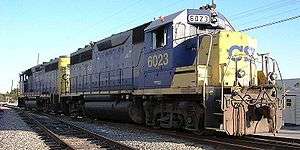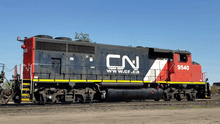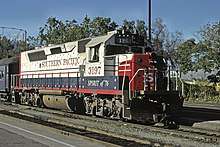EMD GP40-2
The EMD GP40-2 is a 4-axle diesel road switcher locomotive built by General Motors Electro-Motive Division as part of its Dash 2 line between April 1972 and December 1986. The locomotive's power is provided by an EMD 645E3 16-cylinder engine which generates 3,000 horsepower (2.24 MW).
| EMD GP40-2 | |||||||||||||||||||||||||||
|---|---|---|---|---|---|---|---|---|---|---|---|---|---|---|---|---|---|---|---|---|---|---|---|---|---|---|---|
 A pair of EMD GP40-2 coupled back-to-back for use in remote control switching operations - Tampa, Florida. | |||||||||||||||||||||||||||
| |||||||||||||||||||||||||||
| |||||||||||||||||||||||||||
| |||||||||||||||||||||||||||
Production
Standard GP40-2 production totalled 861 units, with 817 built for U.S. railroads, and 44 for Mexican railroads. In addition, three GP40P-2s, passenger versions of the GP40-2, were built in 1974 and 279 were built by General Motors Diesel (GMD) between 1974 and 1976. Total production of the GP40-2 and its variations totalled 1,143 units.
Performance
With the 62:15 gearing (65-70 mph maximum) EMD rated the GP40-2 at 55,400 lb continuous tractive effort. Some had PF21 module that reduced the output below 23 mph, lowering continuous speed down to 11 mph.
Original buyers
| Owner | Quantity | Numbers | Notes |
|---|---|---|---|
| Atlanta and West Point Rail Road | 1 | 733 | to Seaboard System Railroad to CSX |
| Alaska Railroad | 10 | 3000, 3007–3015 | 3000 renumbered to 3006 |
| Baltimore and Ohio Railroad | 218 | 4100–4162, 1977, GM50, 4185–4256, 4287–4311, 4322–4351, 4422–4447 | Chessie System paint to CSX |
| Boston and Maine Railroad | 18 | 300–317 | |
| Chesapeake and Ohio Railway | 95 | 4165–4184, 4267–4281, 4372–4421 | Chessie System paint to CSX |
| Ferrocarril Chihuahua al Pacífico | 29 | 1008–1036 | |
| Conrail | 129 | 3275–3403 | To CSX and Norfolk Southern Railway, #3275-3279 ex-Reading Company |
| Denver and Rio Grande Western Railroad | 37 | 3094–3130 | All to Union Pacific Railroad. |
| U.S. Department of Transportation | 1 | 003 | |
| Detroit, Toledo and Ironton Railroad | 20 | 406–425 | to Grand Trunk Western Railroad 6406–6425. |
| Florida East Coast Railway | 24 | 411–434 | 433–434 were last built |
| Georgia Railroad | 2 | 755–756 | to Seaboard System Railroad to CSX |
| Kansas City Southern Railway | 4 | 796–799 | |
| Louisville and Nashville Railroad | 17 | 6600–6616 | Family Lines Paint, to Seaboard System Railroad to CSX |
| Reading Company | 5 | 3671–3675 | |
| Richmond, Fredericksburg and Potomac Railroad | 7 | 141–147 | to CSX |
| St. Louis – San Francisco Railway ("Frisco") | 25 | 750–774 | to Burlington Northern 3040–3064 |
| St. Louis Southwestern Railway ("Cotton Belt") | 56 | 7248–7273, 7628–7657 | |
| Seaboard Coast Line Railroad | 25 | 1636–1656. 6617–6621 | 6617–6621 Family Lines paint; all to Seaboard System Railroad now CSX |
| Ferrocarril Sonora-Baja California | 15 | 2104–2112, 2309–2314 | 2104-2112 have High short hoods w/steam generator for passenger service only GP40-2 built with high short hoods |
| Southern Pacific Transportation Company | 68 | 7240–7247, 7608–7627, 7658–7677, 7940–7959 | |
| Texas, Oklahoma and Eastern Railroad | 3 | D15–D16, D20 | |
| Western Maryland Railway | 35 | 4257–4261,4312–4321, 4352–4371 | Chessie System paint to CSX |
| Western Pacific Railroad | 15 | 3545–3559 | |
| Western Railway of Alabama | 1 | 708 | to Seaboard System Railroad to CSX |
| Total | 861 |
- Units built by General Motors Diesel, Canada

| Railroad | Quantity | Road numbers | Notes |
|---|---|---|---|
| Canadian National Railway | 268 | CN 9400–9667, 9668–9677 | CN 9400–9632 are GP40-2L, 9633–9677 are GP40-2W. CN 9668–9677 are former GO Transit units purchased in 1991. |
| GO Transit | 11 | GO 700–710 | Ten to CN 9668–9677 in 1991. One (703) to Miami Tri-Rail, later sold to Aberdeen, Carolina & Western #703. |
| Total | 279 | ||
- GP40P-2

| Railroad | Quantity | Road numbers | Notes |
|---|---|---|---|
| Southern Pacific Transportation Company | 3 | 3197-3199 | |
| Total | 3 | ||
References
- Foster, Gerald (1996). A Field Guide to Trains. New York, NY: Houghton Mifflin Company. ISBN 0-395-70112-0.
- Pinkepank, Jerry A. (1973). The Second Diesel Spotter's Guide. Milwaukee, Wisconsin: Kalmbach Publishing. ISBN 978-0-89024-026-7.
- Kristopans, Andre. "GM Serial Number Webpage". Archived from the original on 2013-02-22.
- Adel, Aaron. "Transit Toronto Webpage".
External links
| Wikimedia Commons has media related to EMD GP40-2 locomotives. |
- Sarberenyi, Robert. EMD GP40-2, GP40-2W, and GP40-2LW, GP40P-2 Original Owners
- CN GP40 Family
- GP40-2 order numbers
- EMD GP40-2 Proto Info: Conrail Cyclopedia